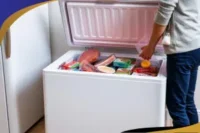How to Use a Refrigerator for the First Time
Published: 19 Sep 2025
So, you’ve bought a new fridge, and you’re wondering how to use a refrigerator for the first time. Setting up your fridge the right way is important to make sure it works well and keeps your food fresh.
How can you make your fridge last longer and keep it working like new? What are the good and bad sides of using a refrigerator? This article will answer these questions and guide you step by step.
Before we begin, here are a few things you’ll need to set up your refrigerator:
- A stable stand (if required)
- A shaded area or room for placement
- A power outlet for electricity
- Enough space around the fridge for airflow
Let’s not waste time and get started with the details!
1. Allow the Refrigerator to Settle
When your refrigerator is placed in its final location, let it stand upright for a while before plugging it in. This helps the fridge “rest” and ensures it works properly.
During transport, the oil inside the compressor may mix with the gas in the cooling system. This can affect the refrigerator’s performance. Carefully follow these steps to prevent any possible issues.
- If the fridge was carried upright, wait at least 1 hour before turning it on.
- If the fridge was carried on its side or upside down, let it rest for 4 to 6 hours before plugging it in.
Allowing the fridge to settle will prevent damage and help it cool your food efficiently.
2. Initial Cleaning
Before using your refrigerator for the first time, it’s important to clean the inside. This helps remove any dust or leftover residues from the factory, ensuring a fresh start for your food storage.
- Use Mild Detergent
Mix a gentle detergent with warm water for safe and effective cleaning. - Wipe Down All Surfaces
Clean the shelves, drawers, and door compartments thoroughly. - Dry Completely
Make sure all surfaces are fully dry before placing food back inside. - Close the Doors
After cleaning and drying, close the doors to keep the inside fresh.

Following these steps will help prevent odours and keep your refrigerator clean and ready to use.
3. Setting the Temperature
To keep your food fresh and safe, setting your refrigerator and freezer to the correct temperatures is important. This ensures that your food stays at the right temperature and lasts longer.
- Refrigerator Temperature
Set the fridge to 37°F (3°C) to keep food fresh and safe. - Freezer Temperature
Adjust the freezer to 0°F (-18°C) for proper storage of frozen items. - Check the Settings
Most fridges have simple temperature controls that you can adjust anytime.

By setting the right temperatures, your food will stay fresh, and your fridge will work efficiently.
4. Proper Food Organization
Before storing any food in your new refrigerator, it’s important to empty it for at least 10 hours. This ensures that your fridge has reached the right temperature and is ready to store your food safely.
- Top Shelves
Best for ready-to-eat foods like leftovers, dairy products, and pre-cooked meals. - Middle Shelves
Store beverages, condiments, and eggs here for easy access. - Bottom Shelves
Place raw meat and seafood on the bottom shelf to avoid juices dripping onto other foods. - Crisper Drawers
Use these for fruits and vegetables. Adjust the humidity settings to keep them fresh for longer.

Organizing your food properly keeps everything fresh and helps prevent cross-contamination between different types of food.
5. Pros and Cons of Using a Refrigerator
Refrigerators are essential for keeping food fresh, but they have advantages and disadvantages like everything else. Let’s look at some of the pros and cons of using a refrigerator.
Advantages of Using a fridge
First, we know some of the benefits of using a fridge.
| Pros |
|---|
1. Keeps Food Fresh LongerA refrigerator maintains the right temperature and humidity, which helps keep your food fresh for a longer time. 2. Saves Money on Energy BillsUsing the correct settings and maintaining your fridge can reduce electricity usage, helping you save on energy costs. 3. Prevents Food WasteBy storing food correctly, you can avoid spoilage and waste less food. |
Disadvantages of Using a Fridge
Secondly, we will know some disadvantages of using the fridge.
| Cons |
|---|
1. Needs Regular MaintenanceCleaning the coils, checking seals, and replacing filters must be done regularly to keep the fridge working well. 2. Limited SpaceIf you overfill the fridge or leave it too empty, it might not cool properly, affecting food quality and energy efficiency. |
6. Warnings and Tips for Using the Refrigerator
Using a refrigerator is essential for keeping your food fresh, but some things must be remembered to ensure it works properly. Here are some helpful warnings and tips to make the most of your refrigerator.
Warnings:
Here are a few things you should avoid to keep your fridge running smoothly:
- Don’t Overload the Fridge
Overstuffing can block air circulation and make it hard for the fridge to cool properly. - Keep the Door Closed
Opening the door too often lets warm air in and raises the inside temperature. - Check the Temperature Regularly
Make sure the fridge is set to 37°F (3°C) and the freezer to 0°F (-18°C).

We’ve covered the warnings, so let’s move on to some useful tips.
Tips:
Let’s look at some easy tips that will keep your fridge running smoothly and your food safe:
- Clean the Coils
Dust off the coils at the back or bottom of the fridge every few months to help it run efficiently. - Use Containers
Store food in clear containers to keep things organized and easy to find. - Label Leftovers
Write dates on leftover containers to track how long they’ve been in the fridge.
Following these warnings and tips can help your refrigerator work better and keep your food fresh!

Having covered all these details, let’s move on to the final takeaway.
Conclusion
Now that you know how to use a refrigerator for the first time and properly maintain it, you’re ready to keep your food fresh and your appliance running efficiently. How did you find our guide? Was it helpful? Do you have any questions or concerns about using your refrigerator?
We’re eager to hear from you! Feel free to share your thoughts and feedback in the comments below, and let us know how we can assist. Keep in mind that maintaining your fridge helps preserve food quality and reduce waste.
Frequently Asked Questions
Here are some questions that might come to your mind while reading this article:
- How do you use a fridge for the first time?
- How to properly use your fridge?
- How do fridges work step by step?
- What is colder in a fridge, 1 or 6?
- Can we use a new fridge immediately?
- What is the proper use of a refrigerator?
- What should I store in the refrigerator door compartments?
- How can I reduce odours inside my refrigerator?
- How often should I clean my refrigerator?
- What is the best way to store fruits and vegetables?
Are you ready to read the answers to these questions? Let’s start!
A: When using a fridge for the first time, allow it to stand upright for 4-6 hours after moving it. Then, clean the interior and set the correct temperature (37°F for the fridge and 0°F for the freezer). Organize your food correctly and avoid overloading it during the initial use to let the cooling system stabilize.
A: To properly use your fridge, always keep it at the correct temperature, avoid overloading the shelves, and regularly clean the condenser coils. Organize food items correctly by storing raw meat on the bottom shelves and ensuring that the door seals are airtight to maintain efficiency.
A: Refrigerators work by circulating refrigerant through a system of coils. The refrigerant draws heat from the interior, which cools the air inside. This process is controlled by a thermostat that turns the compressor on and off to maintain the desired temperature.
A: The number settings on a refrigerator indicate the cooling intensity. Typically, a higher number means a colder setting, so 6 is colder than 1. However, this can vary by brand, so always check the user manual for details.
A: No, you should not use a new fridge immediately. After placing it in your home, let it sit upright for at least 4-6 hours before plugging it in. This allows the compressor oil to settle and prevents potential cooling issues.
A: The proper use of a refrigerator includes setting the right temperature, organizing food items correctly, cleaning the interior regularly, and ensuring that door seals are airtight. Avoid placing hot food directly inside, and do not overstuff the shelves to maintain proper airflow.
A: The refrigerator door compartments are best for items that can handle slight temperature changes, such as condiments, juices, and sauces. Avoid storing eggs or milk here, as they need more consistent temperatures.
A: To minimize odours, use airtight containers for food storage, clean up spills immediately, and place an open box of baking soda inside to neutralize unwanted smells.
A: You should clean your refrigerator at least once every few months. This involves wiping surfaces, organizing shelves, and discarding any expired food.
A: Store fruits and vegetables in crisper drawers to keep them fresh. Make sure to separate them, as some fruits can release gases that may spoil vegetables faster.
So guys, it’s time to say goodbye, but before that, I would like to tell you one thing: you must read our guide that we have created just for you. What are the advantages and disadvantages of a refrigerator?





